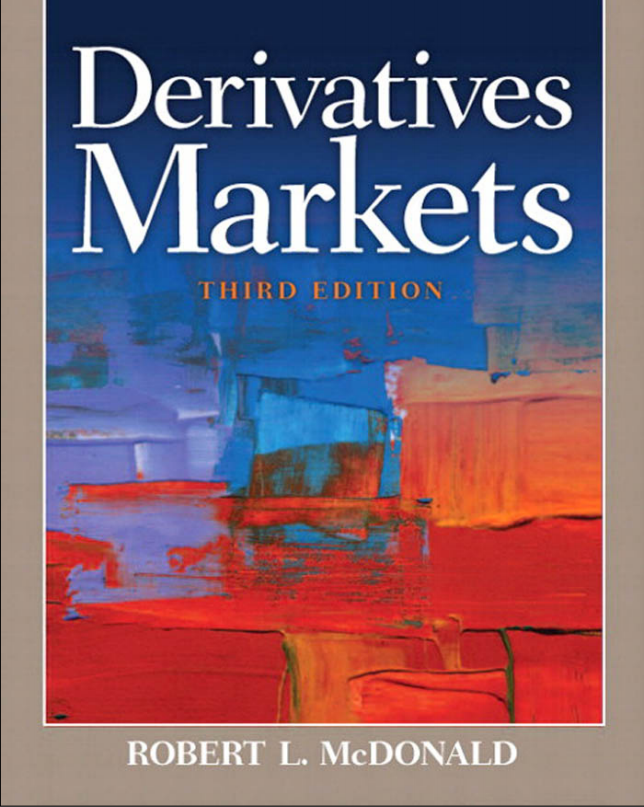Derivatives Markets by Robert L. McDonald

1
Introduction to Derivatives
The world of finance has changed dramatically in recent decades. Electronic processing,
globalization, and deregulation have all transformed markets, with many of the most
important changes involving derivatives. The set of financial claims traded today is quite
different than it was in 1970. In addition to ordinary stocks and bonds, there is now a wide
array of products collectively referred to as financial derivatives: futures, options, swaps,
credit default swaps, and many more exotic claims.
Derivatives sometimes make headlines. Prior to the financial crisis in 2008, there were
a number of well-known derivatives-related losses: Procter & Gamble lost $150 million in
1994, Barings Bank lost $1.3 billion in 1995, Long-Term Capital Management lost $3.5
billion in 1998, the hedge fund Amaranth lost $6 billion in 2006, Societ´ e G´ en´ erale lost ´ =C5
billion in 2008. During the crisis in 2008 the Federal Reserve loaned $85 billion to AIG in
conjunction with AIG’s losses on credit default swaps. In the wake of the financial crisis, a
significant portion of the Dodd-Frank Wall Street Reform and Consumer Protection Act of
2010 pertained to derivatives.
What is not in the headlines is the fact that, most of the time, for most companies
and most users, these financial products are a useful and everyday part of business. Just
as companies routinely issue debt and equity, they also routinely use swaps to fix the
cost of production inputs, futures contracts to hedge foreign exchange risk, and options
to compensate employees, to mention just a few examples.
Besides their widespread use, another important reason to understand derivatives is
that the theory underlying financial derivatives provides a language and a set of analytical
techniques that is fundamental for thinking about risk and valuation. It is almost impossible
to discuss or perform asset management, risk management, credit evaluation, or capital
budgeting without some understanding of derivatives and derivatives pricing.
This book provides an introduction to the products and concepts underlying derivatives.
In this first chapter, we introduce some important concepts and provide some background
to place derivatives in context. We begin by defining a derivative. We will then
briefly examine financial markets, and see that derivatives markets have become increasingly
important in recent years. The size of these markets may leave you wondering exactly
what functions they serve. We next discuss the role of financial markets in our lives, and the
importance of risk sharing. We also discuss different perspectives on derivatives. Finally,
we will discuss how trading occurs, providing some basic concepts and language that will
be useful in later chapters.
1.1 WHAT IS A DERIVATIVE?
A derivative is a financial instrument that has a value determined by the price of something
else. Options, futures, and swaps are all examples of derivatives. A bushel of corn is not
a derivative; it is a commodity with a value determined in the corn market. However, you
could enter into an agreement with a friend that says: If the price of a bushel of corn in 1
year is greater than $3, you will pay the friend $1. If the price of corn is less than $3, the
friend will pay you $1. This is a derivative in the sense that you have an agreement with a
value depending on the price of something else (corn, in this case).
You might think: “That doesn’t sound like it’s a derivative; that’s just a bet on the
price of corn.” Derivatives can be thought of as bets on the price of something, but the term
“bet” is not necessarily pejorative. Suppose your family grows corn and your friend’s family
buys corn to mill into cornmeal. The bet provides insurance: You earn $1 if your family’s
corn sells for a low price; this supplements your income. Your friend earns $1 if the corn
his family buys is expensive; this offsets the high cost of corn. Viewed in this light, the
bet hedges you both against unfavorable outcomes. The contract has reduced risk for both
of you.
Investors who do not make a living growing or processing corn could also use this kind
of contract simply to speculate on the price of corn. In this case the contract does not serve
as insurance; it is simply a bet. This example illustrates a key point: It is not the contract
itself, but how it is used, and who uses it, that determines whether or not it is risk-reducing.
Context is everything.
If you are just learning about derivatives, the implications of the definition will not be
obvious right away. You will come to a deeper understanding of derivatives as we progress
through the book, studying different products and their underlying economics.
1.2 AN OVERVIEW OF FINANCIAL MARKETS
In this section we will discuss the variety of markets and financial instruments that exist.
You should bear in mind that financial markets are rapidly evolving and that any specific
description today may soon be out-of-date. Nevertheless, though the specific details may
change, the basic economic functions associated with trading will continue to be necessary.
Trading of Financial Assets
The trading of a financial asset—i.e., the process by which an asset acquires a new owner—
is more complicated than you might guess and involves at least four discrete steps. To
understand the steps, consider the trade of a stock:
1. The buyer and seller must locate one another and agree on a price. This process is
what most people mean by “trading” and is the most visible step. Stock exchanges,
derivatives exchanges, and dealers all facilitate trading, providing buyers and sellers
a means to find one another.
2. Once the buyer and seller agree on a price, the trade must be cleared, i.e., the
obligations of each party are specified. In the case of a stock transaction, the buyer




